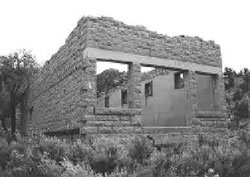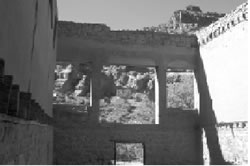Coal Mining
Town of Sego -
Gone but not Forgotten
by Jeff Richards
Fifty-seven
years ago, on Nov. 1, 1947, an illustrious chapter
in Grand County’s
history was closed when the once-bustling Sego coal mine
officially closed down. The town of Sego was later sold
at auction in Moab, and many of the buildings were moved
off the property. Today, Sego (a few miles north of Thompson
Springs) is but a ghost town, although many remnants
of original structures are still standing.

Unlike other area mining towns which built their fortunes
on precious metals like gold and silver, Sego was founded
on coal. Its beginnings started in the early 1900s,
when an Englishman named Harry Ballard, who lived in
Thompson Springs, found a large seam of anthracite
coal in the hills near the Book Cliffs. Recognizing
the coal’s potential
value, Ballard started putting a small mining operation together, including
the building of a railroad spur to get the coal from the hills to the
railway at Thompson.
The five-mile rail line up what is now called Sego Canyon proved difficult
to lay, and more than a dozen bridges were needed to pass over the
wash that zigzags through the canyon. Although flash floods frequently
plagued the rail spur over the years, the railroad (first incorporated
as the Ballard&Thompson Railroad in 1911) eventually managed to
transport countless tons of coal over a period of nearly four decades.
In early 1912, Ballard sold his small operation to the American Fuel
Company, a Salt Lake City company. Soon afterward, the mining camp
known as Ballard was renamed Neslen, after AFC’s general manager,
Richard F. Neslen. By 1913, the B&T Railroad had become a subsidiary
of the Denver Rio Grande and Western Railroad, which also used much
of the coal to power its own steam engine locomotives.
 The
Dec. 20, 1912 edition of Moab’s weekly newspaper, the Grand Valley
Times, described the camp of Neslen as follows: “Extensive yards
were made to provide for the economical handling of large tonnages
of coal …springs far up the mountain canyons were tapped and
pure, cool water was brought by pipe line to the homes and industrial
plants of the little city, giving ample fire protection to the workmen’s
homes and cool, clear, pure water for their domestic use.”
The
Dec. 20, 1912 edition of Moab’s weekly newspaper, the Grand Valley
Times, described the camp of Neslen as follows: “Extensive yards
were made to provide for the economical handling of large tonnages
of coal …springs far up the mountain canyons were tapped and
pure, cool water was brought by pipe line to the homes and industrial
plants of the little city, giving ample fire protection to the workmen’s
homes and cool, clear, pure water for their domestic use.”
Added the Times, “A large and commodious hotel, private dwellings
and a temporary store building were constructed. A club house for employees
and a mammoth stone store and office building are nearing completion.” Today,
in 2003, the walls of the stone company store remain solid and intact,
although little else of the building remains. The two-story clubhouse
across the street is badly deteriorating, as are several other wooden
buildings in the area. Many of Sego’s remaining structures are
on private property, although a public dirt road passes through the
area.
Working conditions in the early years of the Neslen mine were rough,
and the miners were paid irregularly, sometimes going months without
a payday. Often, they were paid in “scrip,” redeemable
only for merchandise at the company store. Prices in nearby Thompson
were reportedly much lower, but workers were told they would be fired
if they went to Thompson to do their shopping. Besides, most workers
didn’t have a way to get to the town, other than by walking.
Another problem that plagued the mine throughout its history was the
lack of plentiful water. Despite the springs and wells, the water table
of the area was often too low to meet the substantial demands of the
mine, which reportedly boasted the first “coal washing” facility
west of the Mississippi.
According to the aforementioned 1912 newspaper account, AFC’s
company motto at the time was as follows: “Substantial construction,
and the best of equipment to be had, regardless of cost,” with
the result being, “The cleanest and best prepared coal on the
market today.”
However, in 1918, AFC’s interests in the mining operation were
bought out by another company, the Chesterfield Coal Company. Soon
after, the name of the town was changed to Sego, after Utah’s
state flower, the sego lily, which had also been the name of a brand
of condensed milk that had lined the shelves of the company store.
Reportedly, the superintendent’s wife had seen the cans of milk
and had said “Sego” out loud while a group of men were
sitting in the store deciding what to rename the town. The men immediately
liked the name, and the new moniker caught on quickly.
By 1920, Sego boasted a population of 200 people, with another 85 or
so living in nearby Thompson. The 1920s and 1930s were Sego’s
heyday, and its population reached as high as 500, making it one of
the major cities of Grand County. In May of 1928, it was the busiest
coal camp anywhere in Utah, with a reported output of 1,500 tons of
coal per day by a 150-man crew. In 1933, the miners of Sego finally
agreed to become unionized when they joined the United Mine Workers
Union. But during the ensuing Great Depression and throughout World
War II, it became much more difficult for the coal mining industry
to remain viable and profitable. Coal dropped greatly in both price
and demand, particularly when the railroads switched to diesel fuel.
That, along with numerous other socioeconomic factors, led to the eventual
demise of the Sego mine. A few diehard miners tried to resurrect the
operation for a few years in the early 1950s, but their efforts were
ultimately unsuccessful.
Today, several of the old buildings of Sego can be seen from the dirt
road that passes through the canyon, as can a small private cemetery
at the side of the road. There are also a number of interesting Native
American petroglyphs in the area, including one Barrier Canyon style
panel (as old as 2000 B.C.) that is also covered with Fremont-era petroglyphs
(ca. A.D. 600-1250). Paleontologists reportedly made a number of important
fossil finds in the area during the 1930s and 1940s, including some
large dinosaur footprints that were sent to the American Museum of
Natural History in New York. Sego therefore provides a snapshot of
both the prehistoric and the not-too-distant historic past.


 The
Dec. 20, 1912 edition of Moab’s weekly newspaper, the Grand Valley
Times, described the camp of Neslen as follows: “Extensive yards
were made to provide for the economical handling of large tonnages
of coal …springs far up the mountain canyons were tapped and
pure, cool water was brought by pipe line to the homes and industrial
plants of the little city, giving ample fire protection to the workmen’s
homes and cool, clear, pure water for their domestic use.”
The
Dec. 20, 1912 edition of Moab’s weekly newspaper, the Grand Valley
Times, described the camp of Neslen as follows: “Extensive yards
were made to provide for the economical handling of large tonnages
of coal …springs far up the mountain canyons were tapped and
pure, cool water was brought by pipe line to the homes and industrial
plants of the little city, giving ample fire protection to the workmen’s
homes and cool, clear, pure water for their domestic use.”